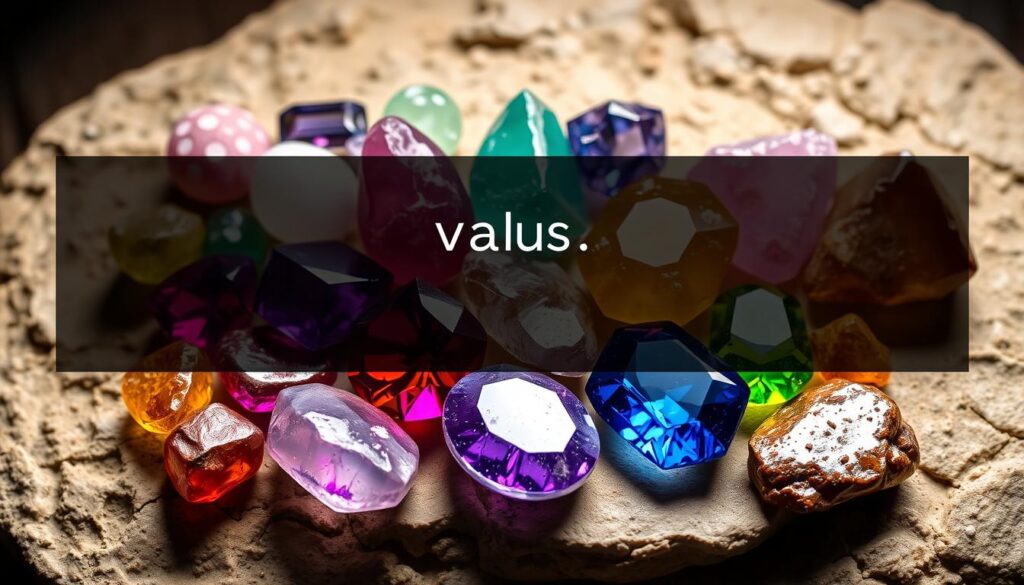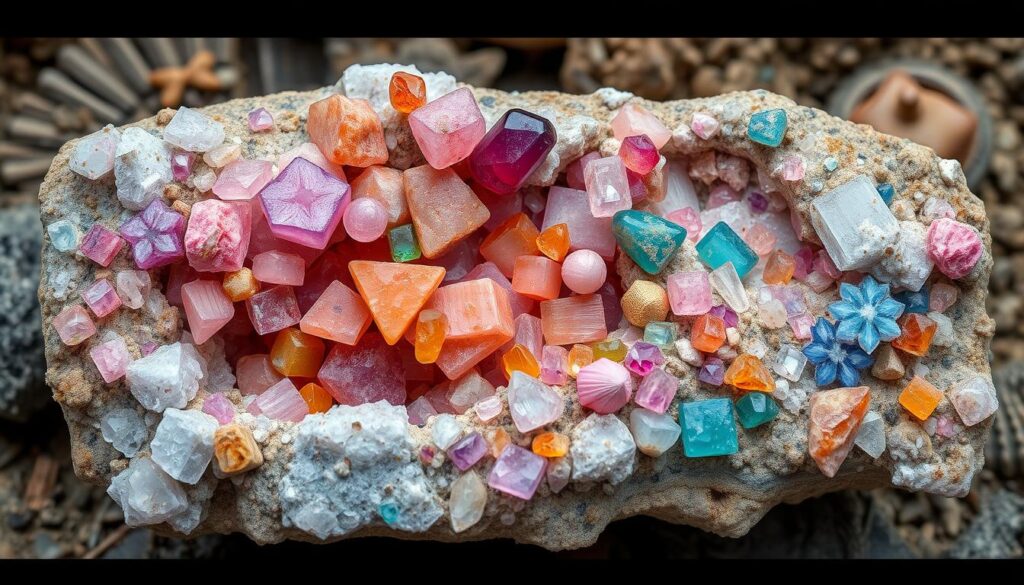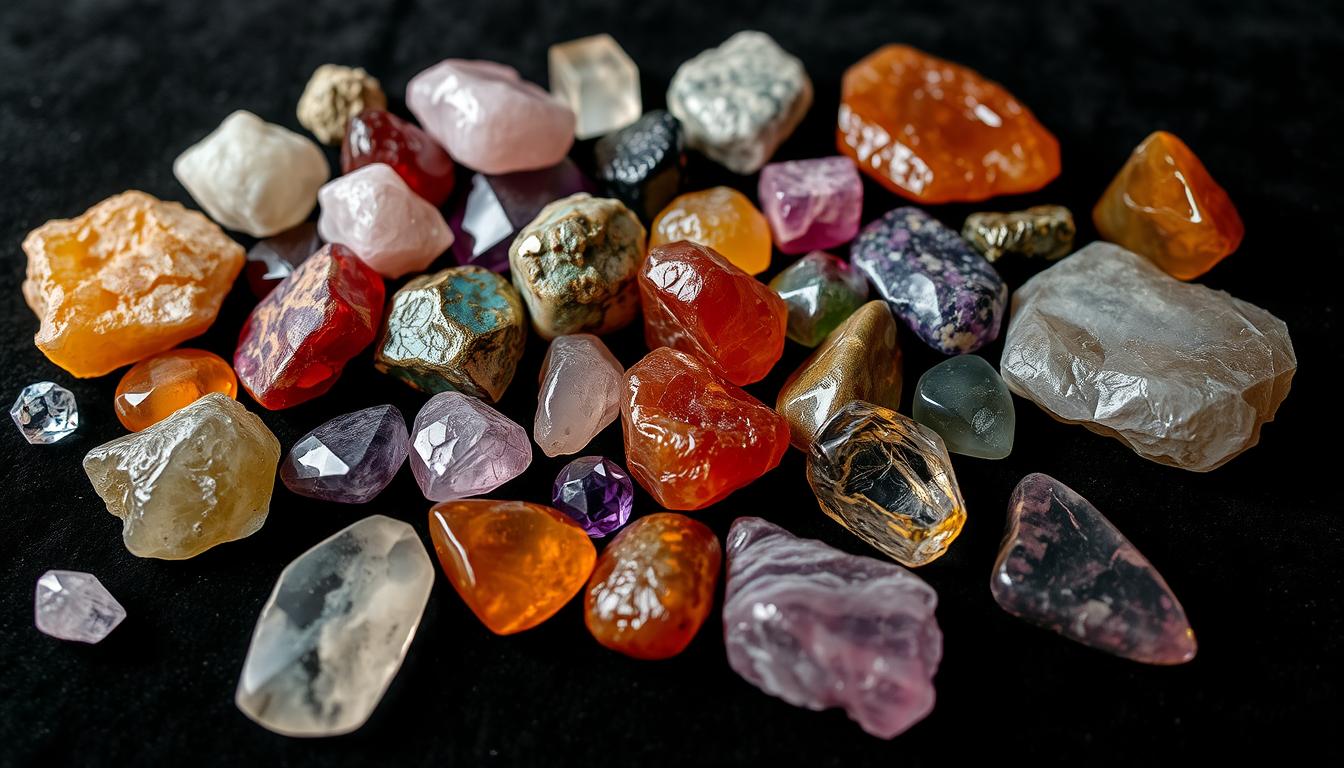This post contains affiliate links.
Ever wondered about the hidden beauty in uncut gemstones? These natural wonders, straight from the Earth, have a captivating allure. From sapphires’ deep blues to rubies’ fiery reds, raw gemstones show nature’s artistry.
In this guide, we’ll dive into the world of uncut precious and semi-precious stones. You’ll learn what makes these gems special, from their Earthly origins to their value. Whether you’re starting to collect or just curious, get ready to discover raw gemstones’ secrets.
Did you know February’s birthstone, amethyst, has stunning purple crystals in its raw form? Or that May’s birthstone, emerald, is mined in North Carolina? These facts show the diverse origins and qualities of precious gemstones in their natural state.
As we explore further, you’ll see what makes raw gemstones valuable. Color, transparency, and size are key. We’ll also look at how a gemstone’s origin, like Madagascar’s rich regions, affects its value.
Key Takeaways
- Raw gemstones offer unique beauty in their natural, uncut state
- Color, transparency, and size are crucial factors in determining a gemstone’s value
- Geographical origin plays a significant role in a gemstone’s worth
- Some gemstones, like fluorite, have special properties such as fluorescence
- Understanding market trends and rarity is key to assessing a raw gemstone’s potential
Ready to explore the world of raw gemstones? Let’s start by understanding what makes these natural treasures unique compared to their polished counterparts.
Understanding Raw Gemstones: Nature’s Untouched Treasures
Raw gemstones show the beauty of nature, giving us a peek into Earth’s wonders. These minerals, untouched by humans, reveal the raw beauty of gemstone formations. They invite us to discover their wild charm.
Defining Raw vs. Cut Gemstones
Raw gemstones are nature’s art, untouched by humans. They differ from polished stones, keeping their original shape. This shows the true beauty of their creation. Cut gemstones, shaped for brilliance and sale, are different.
The Natural Formation Process
Gemstones form over millions of years through Earth’s processes. Deep inside, heat and pressure turn minerals into crystals. This slow process creates unique patterns and inclusions, telling each stone’s story.
Common Types of Crystal Structures
Gemstone crystals have different shapes based on their molecular structure. Diamonds have cubic structures, forming perfect squares. Quartz, with hexagonal crystals, shows six-sided prisms. Zircons have tetragonal systems, with elongated shapes and square cross-sections.
- Cubic: Diamonds, garnets
- Hexagonal: Quartz, beryl
- Tetragonal: Zircon, rutile
Knowing about these structures helps us see the beauty and value of raw gemstones. Each crystal’s formation tells a story of Earth’s history. This makes them special to collectors and jewelry lovers.
The Value Factors of Natural Gemstones
Natural gemstones are truly captivating with their beauty and rarity. Knowing what makes them valuable is key to appreciating them. Let’s dive into the main factors that determine the worth of precious and semi-precious gemstones.

Color is a big factor in gemstone value. Stones with bright, vivid colors are more expensive. For example, deep red rubies and bright blue sapphires are highly prized. Clarity also plays a role, with clearer stones being more valuable.
Size is important too. Larger, high-quality stones are rarer and more valuable. A 3-carat natural ruby or sapphire, for instance, is more expensive than a 1-carat gem of similar quality.
Rarity greatly affects gemstone value. The less available a stone is, the higher its price. This is why diamonds, rubies, emeralds, and sapphires are considered the most valuable.
| Gemstone | Price Range (per carat) |
|---|---|
| Diamond | $4,500 – $6,000 |
| Ruby | $4,625 |
| Emerald | $500 – $1,100 |
| Sapphire | $450 – $1,600 |
Market demand and trends also impact gemstone value. What’s in style can make certain stones more popular. For example, opal and turquoise have seen a rise in popularity, with prices between $60 to $100 per carat.
A well-cut gemstone can greatly enhance its value. The cut combines color, clarity, and carat weight to achieve the best value. By understanding these factors, you’ll better appreciate the true worth of natural gemstones.
Essential Characteristics of Precious Stones
Precious stones are known for their beauty and rarity. Knowing about gemstone characteristics helps us see their true value. Let’s look at what makes a gemstone quality.
Color Intensity and Saturation
The color of a gemstone greatly affects its value. Bright, vivid colors usually mean a higher price. For example, a Burmese ruby’s deep red or a Ceylon sapphire’s rich blue are highly valued for their color.
Transparency and Clarity Levels
A gem’s clarity is key to its brilliance and value. Stones with fewer inclusions are more sought after. Diamonds, for instance, are graded from flawless to included. The fewer imperfections, the more valuable.
Crystal Size and Formation
In the world of precious stones, size is important. Larger, high-quality gems are rarer and more valuable. The shape and completeness of a crystal also matter. Well-formed crystals with distinct faces are often prized by collectors.
| Gemstone | Hardness (Mohs Scale) | Crystal System |
|---|---|---|
| Diamond | 10 | Cubic |
| Ruby/Sapphire | 9 | Trigonal |
| Emerald | 7.5-8 | Hexagonal |
These factors together determine a gem’s quality. Whether you’re buying or just looking, knowing these details makes you appreciate precious stones more.
Matrix and Formation Environment
The story of a gemstone starts deep in the Earth’s crust. Gemstone deposits form under special conditions, making them beautiful and valuable. Learning about mineral matrices and crystal growth helps us appreciate these natural wonders.
Understanding Mineral Matrices
Mineral matrices are the host rocks where gemstones form. These matrices are the building blocks for crystal growth. Different rocks create different environments for gemstone formation.

Geological Conditions Impact
Geological events greatly influence gemstone formation. Pressure, temperature, and chemical composition are key factors. For instance, metamorphic processes create gemstones when rocks face increased pressure and temperature during tectonic events.
| Geological Event | Time Period | Gemstone Formation |
|---|---|---|
| East African Orogeny | 750-450 million years ago | Various gemstones in East Africa |
| Himalayan Orogeny | 60 million years ago – present | Gemstones in the Himalayan region |
Crystal Growth Patterns
Crystal growth patterns shape a gemstone’s final form. These patterns depend on the environment and available space. Understanding crystal growth helps in appreciating the unique characteristics of each raw gemstone.
- Slow cooling allows larger crystals to form
- Rapid cooling results in smaller crystals
- Chemical composition affects crystal structure
By studying mineral matrices, geological conditions, and crystal growth patterns, we gain insight into the fascinating world of raw gemstones. Each stone has a unique journey from deep within the Earth to your collection.
Geographical Origins and Their Significance
Gemstones come from all over the world. Each place has its own special features. Knowing where they come from helps us understand their value and rarity.
Gemstones are mined in many ways. Diamonds form deep in the Earth and come up through volcanoes. Other gems like topaz and aquamarine form closer to the surface in hot fluids.
The place a gemstone comes from can change its quality and value. Rubies from Burma are famous for their deep color. Colombian emeralds are known for their clear green color. These differences come from the unique conditions where each gem forms.
The science of rock tumbling can also tell us about a gem’s origin. The patterns and inclusions in a stone can show where and when it formed. For example, amber with oak tree flower hairs tells us it’s from the Baltic Sea region, 20-40 million years ago.
| Gemstone | Notable Origin | Characteristic |
|---|---|---|
| Ruby | Burma (Myanmar) | Deep red color |
| Emerald | Colombia | Vibrant green, high clarity |
| Sapphire | Kashmir | Velvety blue hue |
| Diamond | Botswana | High quality, conflict-free |
Knowing where a gemstone comes from makes it more special. It can also increase its value. This is why collectors and investors look for gems from certain places, making them more sought after.
Market Demand and Pricing Dynamics
The gemstone market is booming, valued at $32.38 billion in 2023. It’s expected to hit $55.96 billion by 2033. This growth shows a 5.6% annual increase, highlighting the rising interest in these precious stones.
Supply Chain Factors
Gemstone prices are shaped by the supply chain. China leads, producing over 80% of the world’s gemstones. The US, with an 84.1% market share in 2022, drives demand through online sales and high quality standards.
Market Trends Analysis
The gemstone market is seeing big changes. In the US, colored gemstones are becoming more popular. In China, the growing middle class is boosting demand for rare stones. This is due to their cultural value and perceived health benefits.
Investment Potential
Investment gemstones are catching the eye of smart buyers. The market’s steady growth shows it’s a promising investment. Companies like Tiffany & Co. and Swarovski Group are leading the way.
| Country | Market Share (2022) |
|---|---|
| United States | 84.1% |
| China | 28.4% |
| India | 31.6% |
| Japan | 35.3% |
| Germany | 15.2% |
Identifying Quality in Raw Gemstones
Raw gemstone identification is key for collectors and investors. To judge uncut gems, look at color, clarity, and crystal structure. These factors are crucial.
Color is very important in gemstone evaluation. The Gemstone Institute of America (GIA) says certain colors can show a gem’s quality. For example, brown or grey colors might lower a stone’s value.
Clarity is also vital. Check for inclusions or flaws in the crystal. Some inclusions are natural and okay, but too many can hurt the gem’s quality and value.
Crystal structure matters a lot. Gems with well-formed crystals and clear faces are more valuable. The size and how complete the crystal is can greatly affect its worth.
| Characteristic | Impact on Quality | Evaluation Method |
|---|---|---|
| Color | High | Visual inspection, spectroscopy |
| Clarity | Medium to High | Magnification, light tests |
| Crystal Structure | Medium | Visual inspection, X-ray diffraction |
To get accurate gemstone evaluation, it’s wise to seek expert advice. Companies like KGK Group are great for this. They provide top-quality, natural stones from the best mines worldwide. Remember, wrong identification can damage gems forever, so getting help from pros is crucial.
Common Treatments and Value Impact
Gemstone treatments are common in the jewelry world. They make stones look better but can lower their value. Enhanced gemstones are generally cheaper than natural ones.
Heat Treatment Methods
Heat treatment is a key gemstone treatment. It boosts color and clarity in many stones. For instance, most aquamarines have been heat-treated to become deep blue.
Chemical Enhancements
Chemical treatments also enhance gemstones. They can change a stone’s color or make it last longer. Onyx is a good example. Almost all black onyx gets a sugar and acid treatment for its color.
Natural vs. Treated Stones
It’s important to know the difference between natural and treated stones. Natural stones are rare and more valuable. For example, natural citrine is rare. Most citrine sold is heat-treated.
| Gemstone | Common Treatment | Frequency |
|---|---|---|
| Ruby | Heat treatment | Very common |
| Sapphire | Heat treatment | Common |
| Pearls | Bleaching | Frequent |
| Diamond | Various treatments | Rare |
Always ask about treatments when buying gemstones. Knowing if a stone is natural or enhanced helps you understand its value.
Collecting and Preserving Raw Specimens
Gemstone collecting is a fun hobby that needs careful attention. You must have a system for storing and keeping records of your raw gemstone specimens. Many new collectors forget this step, but it’s key to keep your gems’ value and beauty.
Proper storage is crucial for raw gemstone preservation. Use organizers with drawers or display cases with glass tops to protect your gems. Store harder stones away from softer ones to avoid scratches. Clean your gems gently before storing to remove oils and dirt.
It’s important to keep detailed records of your gemstone specimens. Note each piece’s species, physical description, treatments, and how you got it. Take clear photos to add to your records. You can organize your collection by species, color, or where they come from.
As your collection grows, explore different types of gems. Look for affordable options like quartz, garnet, or topaz. Remember, a gem’s origin can greatly affect its price. For example, Colombian emeralds are often more expensive. With knowledge, careful preservation, and smart choices, you’ll build a valuable and fun gemstone collection.
FAQ
What are raw gemstones?
How do raw gemstones differ from cut gemstones?
What factors determine the value of a raw gemstone?
How are raw gemstones formed?
What are some common crystal structures found in raw gemstones?
How does the geographical origin affect a raw gemstone’s value?
What is the importance of color in raw gemstones?
How does transparency affect a raw gemstone’s value?
What is the significance of the matrix in raw gemstones?
How can you identify quality in raw gemstones?
What are common treatments for raw gemstones, and how do they affect value?
How should raw gemstones be stored and preserved?
Can raw gemstones be considered for investment?
What tools are used to evaluate raw gemstones?
This post contains affiliate links.

